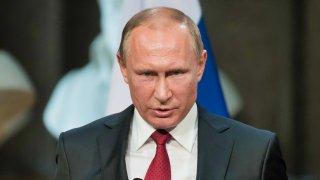Putin's 'War of Choice' in Ukraine Could Mean Russia's 'Outright Ruin'
Putin’s war of choice has sped up internal processes that could lead to Russia’s profound decline – or even its outright ruin.
Since the start of its war on Ukraine in February 2022, Russia has experienced a massive population exodus. Ideological objectors, political opponents, and those simply seeking to avoid conscription have sought the shelter of other nations. Accurate data about this cohort, however, is in short supply, complicated both by Kremlin propaganda and by the fact that some of these exiles have since made their way back to Russia.
A new study by The Bell, a leading Russian opposition news outlet, suggests the ranks of those who fled Russia and still remain abroad is significantly larger than commonly understood.
“The wave of people leaving Russia since February 2022 is the most significant exodus from the country in three decades,” the study notes. That’s something of an understatement. According to recent estimates, more than 800,000 left Russia since the start of the war, marking the largest out-migration since the 1917 Bolshevik Revolution. And while a small percentage has since returned to Russia, the overwhelming majority remain abroad. “At least 650,000 people who left Russia after it invaded Ukraine are still abroad,” according to The Bell.
In absolute terms, that figure represents less than 1% of Russia’s total population of over 146 million. But its impact is outsized on a number of levels.
One is economic. Specifically, the study notes, “those who left Russia can be characterized as highly politicized, well-educated and in a better financial situation than the average Russian. They are typically young (aged 20-40) and 80% have university-level education.” Because of this comparatively high level of achievement, “[t]hey are more likely to run their own businesses or work in white-collar roles such as IT, data analysis, sciences or the creative sector.”
Their departure has exacerbated an already serious problem. Even before Russia’s latest invasion of Ukraine, political scientists were warning that the deepening authoritarianism of President Vladimir Putin’s government was driving out the country’s creative class. Indeed, in the years preceding Russia’s “special military operation” against Ukraine, Russia was seeing an average annual outflow of roughly 100,000 people. Since the start of the current war, the situation has become much, much worse.
That’s because “the hundreds of thousands of those who left are among Russia’s most active and enterprising,” The Bell study notes. As such, their departure “will make it harder for innovation to trickle through the economy and for productivity to increase, potentially hampering Russia’s economic potential for years to come.” The results will be measured in Russia’s declining global competitiveness and economic vibrancy.
Another reason the current exodus is so damaging has to do with demographics. For more than half a century, Russia has been locked in a cycle of deepening population decline, with death and emigration significantly outpacing live births. The situation became a full-blown crisis in the decade after the collapse of the USSR, before rebounding modestly to match European levels of fertility (roughly 1.5 live births per woman). This situation still prevails today.
Even that figure remains well below the fertility rate of 2.1 children per family required for a sustainable replenishment of the Russian population. It has also proven to be stubborn, staying largely static despite numerous Kremlin initiatives designed to boost birth rates. Now, Russia’s war on Ukraine – and the open-ended nature of that conflict – has spurred even steeper decline, as potential conscripts and other objectors eye the national exits.
All of which this augurs potentially momentous changes for the nature of the Russian state. Earlier this year, ROSSTAT, Russia’s official statistics agency, estimated that in a worst case scenario, the national population could drop to 130 million people by the middle of the century. Such a decline would fundamentally upend Russia’s ability to control its vast national territory, which spans eleven time zones. It would be hard to defend territory from the predations of China, with whom Moscow supposedly now boasts a “no limits partnership.”
This brings us back to the true costs of the Ukraine war. Russian officials have made clear that they see the subjugation of their country’s western neighbor as an overriding strategic priority, as well as a prerequisite for renewed national greatness. But, in practical terms, Putin’s war of choice has sped up internal processes that could lead to Russia’s profound decline – or even its outright ruin.
Ilan Berman is Senior Vice President of the American Foreign Policy Council in Washington, DC.

